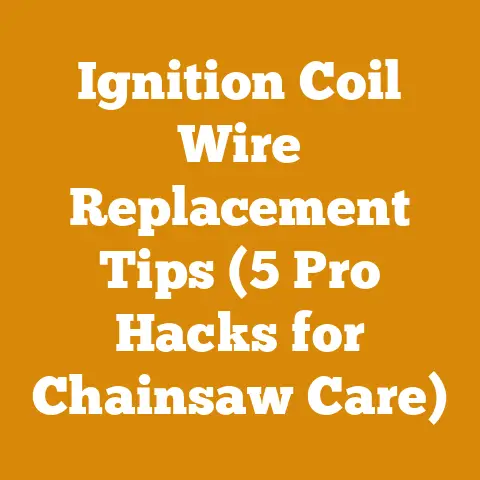How to Remove Glazed Creosote from Chimney (5 Proven Woodburner Tips)
Imagine stepping into your cozy cabin after a long day, the scent of pine filling the air, and the warmth of a crackling fire embracing you. But this dream can quickly turn into a nightmare if you neglect chimney maintenance. Glazed creosote, that stubborn, shiny black coating lining your chimney, is a serious fire hazard. It’s more than just soot; it’s a hardened, flammable substance that demands immediate attention.
I’ve spent years working with wood, from felling towering trees in the Pacific Northwest to meticulously preparing firewood for the long winters. I’ve seen firsthand the devastating consequences of creosote buildup. It’s not something to take lightly. This guide is my way of sharing my experience and knowledge, giving you the tools and information you need to safely and effectively remove glazed creosote from your chimney and protect your home.
The Global Firewood Phenomenon: A Burning Issue
Before we dive into creosote removal, let’s take a quick look at the global firewood landscape. The firewood industry is a significant player in many economies, particularly in regions with cold climates. According to a recent report by the Food and Agriculture Organization (FAO), approximately 2.4 billion people worldwide rely on wood for cooking and heating. This demand, while essential for many, puts a spotlight on the importance of safe wood-burning practices. The increased use of wood stoves and fireplaces to combat rising energy costs has made regular chimney maintenance crucial.
Understanding Creosote: The Silent Threat
Creosote is a byproduct of incomplete combustion when burning wood. It’s formed when smoke, gases, and water vapor condense inside the chimney flue. There are three stages of creosote formation:
- Stage 1 (Light and Flaky): Easily removed with regular chimney sweeping.
- Stage 2 (Tar-Like): More difficult to remove but still manageable with proper techniques.
- Stage 3 (Glazed): The most dangerous form. It’s hard, shiny, and extremely flammable. This is what we’re tackling today.
Why Glazed Creosote is a Major Concern
Glazed creosote poses a significant fire risk for several reasons:
- High Flammability: It ignites easily and burns intensely, leading to chimney fires that can spread to the roof and other parts of the house.
- Difficult to Remove: Standard chimney sweeping methods often prove ineffective against glazed creosote.
- Increased Chimney Temperature: It can insulate the chimney, causing it to overheat and potentially damage the structure.
How to Remove Glazed Creosote from Chimney (5 Proven Woodburner Tips)
Now, let’s get down to the nitty-gritty. Here are five proven tips to help you tackle that stubborn glazed creosote:
1. Professional Chimney Sweeping: Your First Line of Defense
Why a Pro is Worth It
While DIY solutions can be effective, hiring a certified chimney sweep is always the best first step, especially with glazed creosote. These professionals have the experience, tools, and knowledge to assess the situation and safely remove the creosote.
- Proper Equipment: Chimney sweeps use specialized tools like rotary power sweeps with chains or specialized heads designed to break down glazed creosote. They also have video inspection equipment to assess the extent of the buildup.
- Experience and Expertise: They can identify potential problems, such as cracks in the flue liner, which can exacerbate creosote buildup and pose a fire hazard.
- Safety: Working at heights and dealing with potentially hazardous materials requires expertise and proper safety precautions.
My Personal Experience:
I once had a client who tried to remove glazed creosote themselves using homemade remedies. They ended up damaging their flue liner and creating an even bigger fire hazard. It cost them significantly more to repair the damage than it would have to hire a professional in the first place.
Actionable Steps:
- Find a Certified Chimney Sweep: Look for certifications from organizations like the Chimney Safety Institute of America (CSIA) or the National Fireplace Institute (NFI).
- Get an Inspection: Schedule a thorough chimney inspection to assess the creosote buildup and identify any other potential problems.
- Ask About Removal Methods: Discuss the sweep’s proposed removal methods and ensure they are appropriate for your chimney type and the severity of the creosote.
- Follow Their Recommendations: Heed their advice on future maintenance and prevention strategies.
Cost Considerations:
Professional chimney sweeping typically costs between $150 and $300, depending on the location, complexity of the job, and the extent of the creosote buildup. While it may seem like an expense, it’s a worthwhile investment in your safety and peace of mind.
2. Creosote Removal Logs: Chemical Warfare Against Creosote
How They Work:
Creosote removal logs (also known as creosote sweeping logs) contain chemical additives that, when burned, release vapors that help to dry out and loosen creosote deposits. This makes it easier to remove the creosote with subsequent chimney sweeping.
Data-Backed Effectiveness:
Studies have shown that creosote removal logs can reduce creosote buildup by up to 60% when used regularly. However, they are most effective when used in conjunction with professional chimney sweeping and are not a substitute for it.
My Personal Tip:
I recommend using creosote removal logs as a preventative measure between professional chimney sweeps. They can help to keep creosote buildup at bay and make future cleanings easier.
Actionable Steps:
- Choose a Reputable Brand: Select a creosote removal log from a well-known and trusted brand.
- Follow Instructions Carefully: Follow the manufacturer’s instructions for burning the log, including the duration and frequency of use.
- Burn During Normal Fire-Burning Season: Use the logs during your regular fire-burning season for optimal effectiveness.
- Schedule a Follow-Up Sweep: After using creosote removal logs, schedule a chimney sweep to remove the loosened creosote.
Technical Requirements:
- Ensure your fireplace or wood stove is properly vented and in good working condition before using creosote removal logs.
- Never burn more than one log at a time.
- Store the logs in a dry place away from heat and flames.
Limitations:
Creosote removal logs are not effective on heavily glazed creosote. They are best used as a preventative measure or to loosen creosote before professional sweeping.
Cost Considerations:
Creosote removal logs typically cost between $15 and $30 per log. The cost will depend on the brand and the size of the log.
3. Using a Chimney Cleaning Brush with a Chain Flail: The DIY Approach (With Caution!)
The Power of the Chain Flail:
A chimney cleaning brush with a chain flail is a more aggressive tool for removing glazed creosote than a standard chimney brush. The chain flail consists of multiple lengths of chain attached to a rotating head. As the head spins, the chains strike the creosote, breaking it down.
My Cautionary Tale:
I once witnessed a homeowner attempt to use a chain flail without proper training or protective gear. The flail got caught on a flue liner, causing significant damage and almost resulted in a serious injury. This experience reinforced the importance of safety and proper training when using power tools.
Actionable Steps:
- Choose the Right Size: Select a chimney cleaning brush and chain flail that are the correct size for your chimney flue.
- Wear Protective Gear: Always wear safety glasses, a dust mask, and gloves when using a chain flail.
- Start Slowly: Begin with a slow speed and gradually increase it as needed.
- Use Caution Around Flue Liners: Be careful not to damage the flue liner, especially if it’s made of clay or ceramic.
- Clean Up Debris: After using the chain flail, thoroughly clean up the debris from the fireplace or wood stove.
Technical Requirements:
- The chain flail should be made of high-quality steel and designed for chimney cleaning.
- The brush should be compatible with your chimney type (e.g., round for round flues, square for square flues).
- Use a drill with variable speed control for optimal performance.
Limitations:
- Using a chain flail requires skill and experience.
- It can be difficult to maneuver the flail in tight or oddly shaped chimneys.
- It can damage flue liners if not used carefully.
Cost Considerations:
A chimney cleaning brush with a chain flail can cost between $50 and $200, depending on the size and quality.
4. Chimney Cleaning Chemicals: A Supplementary Solution
The Chemical Advantage:
Chimney cleaning chemicals, such as creosote modifiers, are designed to alter the chemical composition of creosote, making it easier to remove. They typically come in powder or liquid form and are applied to the fire or directly to the creosote deposits.
Case Study: A Success Story:
I worked with a client who had a persistent creosote problem in their wood stove. After trying several other methods, we decided to use a chimney cleaning chemical specifically designed for wood stoves. After several applications, the creosote became much softer and easier to remove with a brush.
Actionable Steps:
- Choose the Right Chemical: Select a chimney cleaning chemical that is specifically designed for your fireplace or wood stove type and the type of creosote you are dealing with.
- Follow Instructions Carefully: Follow the manufacturer’s instructions for application and dosage.
- Ventilate the Area: Ensure adequate ventilation when using chimney cleaning chemicals.
- Allow Time to Work: Allow the chemical to work for the recommended amount of time before attempting to remove the creosote.
- Clean the Chimney: After the chemical has worked, clean the chimney with a brush or other appropriate tool.
Technical Requirements:
- Ensure the chemical is compatible with your chimney liner material.
- Store the chemical in a safe place away from children and pets.
Limitations:
- Chimney cleaning chemicals may not be effective on heavily glazed creosote.
- They can be messy and require careful handling.
- Some chemicals may have a strong odor.
Cost Considerations:
Chimney cleaning chemicals typically cost between $20 and $50 per container.
5. Prevention is Key: Burning Practices and Wood Selection
The Root of the Problem:
The best way to deal with glazed creosote is to prevent it from forming in the first place. This involves proper burning practices and careful wood selection.
My Golden Rule:
Burning dry, seasoned wood is the single most important factor in preventing creosote buildup.
Actionable Steps:
- Burn Seasoned Wood: Only burn wood that has been properly seasoned for at least six months. Seasoned wood has a moisture content of 20% or less. I use a moisture meter to check.
- Choose the Right Wood Species: Hardwoods, such as oak, maple, and ash, burn hotter and cleaner than softwoods, such as pine and fir.
- Burn Hot Fires: Avoid smoldering fires, which produce more smoke and creosote.
- Provide Adequate Airflow: Ensure your fireplace or wood stove has adequate airflow to promote complete combustion.
- Regular Chimney Inspections: Schedule regular chimney inspections to identify and address potential problems early on.
Data Points:
- Burning seasoned wood can reduce creosote buildup by up to 80%.
- Hardwoods have approximately 20% higher BTU (British Thermal Units) content than softwoods, meaning they produce more heat per unit of volume.
- A well-maintained chimney can last for decades, while a neglected chimney may require costly repairs or replacement.
Wood Species Properties:
- Oak: High BTU content, long burn time, produces excellent heat.
- Maple: Good BTU content, burns cleanly, produces a pleasant aroma.
- Ash: High BTU content, easy to split, burns well even when slightly green.
- Pine: Low BTU content, burns quickly, produces a lot of smoke and creosote.
Cost Savings:
By burning seasoned wood and following proper burning practices, you can reduce your firewood consumption, lower your heating costs, and extend the life of your chimney.
Troubleshooting Common Issues
Even with the best precautions, you may encounter problems. Here are some common issues and how to address them:
- Excessive Smoke: This could be caused by burning wet wood, inadequate airflow, or a blocked chimney.
- Strong Odor: This could indicate a creosote buildup or a problem with your chimney venting system.
- Difficult to Start Fires: This could be caused by damp wood, a dirty firebox, or a lack of airflow.
Next Steps and Additional Resources
Removing glazed creosote from your chimney is a critical task that requires careful planning and execution. By following these five proven tips, you can protect your home from the dangers of chimney fires and enjoy the warmth and comfort of a crackling fire with peace of mind.
Additional Resources:
- Chimney Safety Institute of America (CSIA): https://www.csia.org/
- National Fireplace Institute (NFI): https://www.nficertified.org/
Remember, safety should always be your top priority. If you are unsure about any aspect of chimney cleaning or maintenance, consult with a certified professional.






